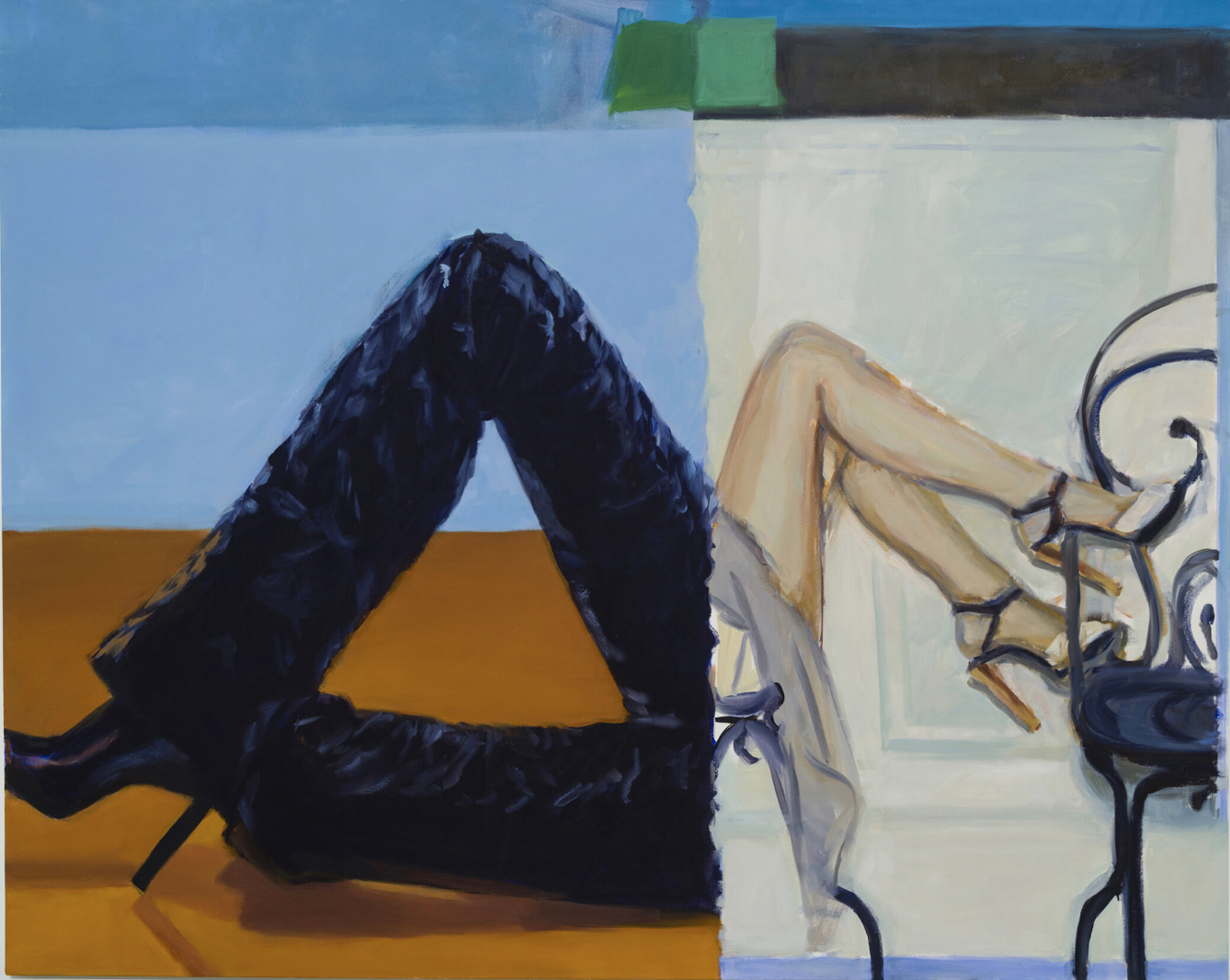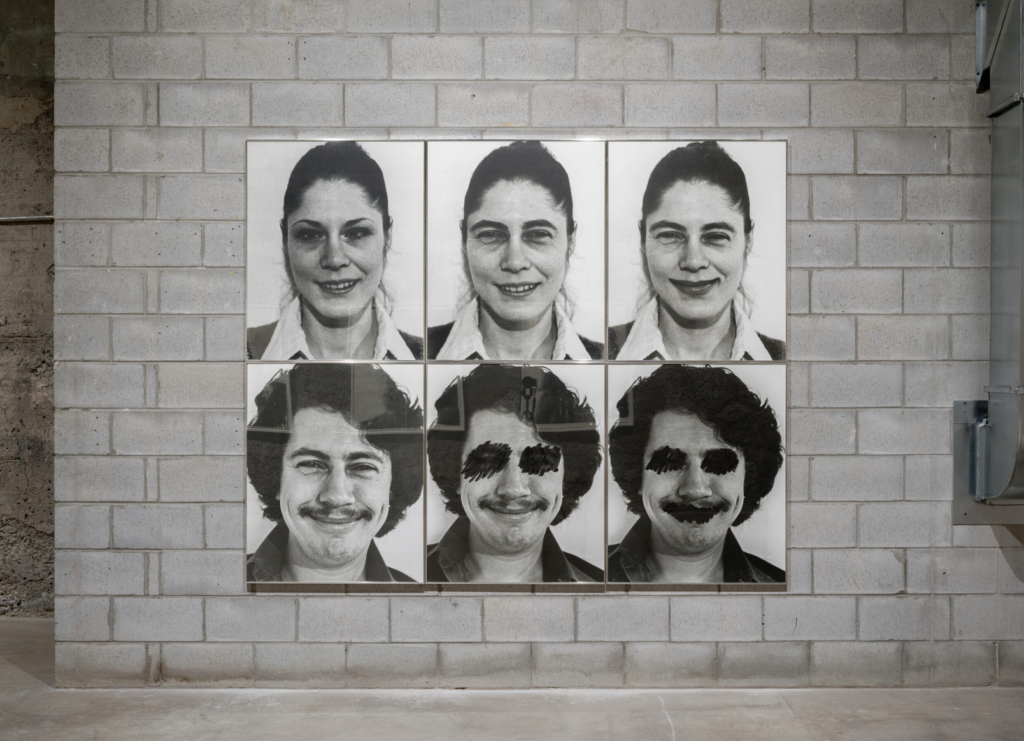Two Artists Harness Camp and the Uncanny at Bradley Ertaskiran


Last month, Bradley Ertaskiran debuted a solo exhibition of new paintings by Montreal-based artist Janet Werner titled Spiders and Snakes, as well as a group exhibition À distance appropriée, featuring work by Sandra Brewster, Suzy Lake, and Joyce Wieland. It was insightful for the gallery to place these exhibits in conjunction with one another, and I found there to be, in the work of Werner and Lake, a particular crossover about harnessing camp and the uncanny. And, to have photographs by Lake that are from the early aughts and 1970s that resonate with Werner’s paintings from the last year speaks to the curatorial efforts on the part of the gallery.
Werner’s solo exhibit, which occupies the entire main gallery, brings to mind magazine cutouts spliced together, and the viewer is presented with an array of sectioned-off body parts in distorted positions. In Aston (2024) and Legs (blue and gold) (2023), Werner’s painted legs are seductive in their positioning, and it is her approach to using paint to splice and cut these singular representations onto one canvas which makes it unsettling, even in the playfulness of the poses.

In Aston, the viewer must adjust their gaze by tilting their head to understand how the image of a woman—casually leaning back in an Aston Martin, wearing a lush fur coat with a deep neckline—might originally have been oriented. The middle of her torso and up are dramatically cut off by the painting’s lower half. Her bare legs lay horizontally across the plane. The legs also add a level of confusion in juxtaposition with the woman’s figure. Whose legs are these, if not hers? The sideways positioning, compared to the upright woman, is curious, also signifying desire and seduction, yet both halves are cropped and incomplete. And since Werner is not cutting and collaging actual magazine ads, but rather carefully executing versions of them in paint, her method of detaching in Aston and the other paintings could be seen as a commentary on the selective erasure in the commodification of women’s bodies. However, through Werner’s looser, unfinished approach and her mischievous manner of destabilizing normative representations of women in pop culture and art history, she allows for a more jovial experience while keeping that larger critique in mind.
In Julianne (2023), Werner places two different, but oddly similar representations of a full-body view of a woman in a frequent editorial pose seen in fashion magazines. On the left side, we see her in a state of exaggerated laughter (a jokey trope as is), with her hand on her hip and outfit, décolletage, and arm unclothed. Her hair is flying around her head and almost covering her entire face. The only indication of her laughter is the warped, broad mouth peering through the sea of hair, which is painted as if in fire-like movement. The right side collides with the left, with presumably the same hair from the woman’s face on the left spilling into the other section. A line, as in Werner’s other works, cuts these two fragments apart, but her use of mirrored body positioning, clothing, and hair melts these two together in a way that confuses them differently. It is this choice on Werner’s part that gives this piece its sense of eeriness. And, because it is a pose most viewers may have seen in ad campaigns (similar to Aston), she muddies the familiar, and the glamorous, but in a way that maintains the pleasure of engaging with these types of commercialized images to contemplate larger, more significant points of inquiry.

While Werner uses painting to appropriate and abstract images of women from mass media, Suzy Lake, on view in the group show in the bunker, harnesses photography and her own body and face to subvert notions of beauty and gender, and does so rather boldly and cartoonishly. For her photographic triptych, Beauty at a Proper Distance/In Song #4 (2002), Lake zooms in and magnifies her own lips, which are painted with bright red lipstick and formed in the shape of an “O,” seen at different angles. Not noticeable at a distance, but upon closer examination, the viewer sees hair sprouting from her chin and upper lip, blemishes, and wrinkles. All are centered around the red lips, which could be seen as mimicking and poking fun at the classic “kiss” gesture. With this work, Lake creates a caricature of glossy commercial photography, which is largely reliant on editing techniques to remove imperfections and signs of aging.

 Suzy Lake. “Suzy Lake as Jay Lee Jaroslav,” 1973-1974/1975. 6 gelatin silver, fiber-based prints mounted on board. Each 30 x 36 in. Courtesy Bradley Ertaskiran.
Suzy Lake. “Suzy Lake as Jay Lee Jaroslav,” 1973-1974/1975. 6 gelatin silver, fiber-based prints mounted on board. Each 30 x 36 in. Courtesy Bradley Ertaskiran.
It should be noted that Lake has been warping her own visage in theatrical, comic, and sincere ways for over fifty years, as seen in Suzy as Jay Lee Jaroslav, created in the 1970s and on view in the bunker. The portraits recall ID photos, school pictures, but due to Lake’s inclusion of increasingly dramatic black lines across their faces, specifically over their smiling mouths, they become a bit unnerving.
Both Werner and Lake accomplish a way in which to consider deeper concerns with respect to gender, portraiture, commercialism, and fine art. Most notably, in using captivating interplays of the uncanny, and at times, camp, they end up providing a space of levity and peculiar pleasure for viewers, but one that does not belie the depth of meaning in their pieces.
Janet Werner Spiders and Snakes and À distance appropriée are both on view at Bradley Ertaskiran through May 4th, 2024. For more information please visit the gallery’s website.
You Might Also Like
Cement Greenberg #13: Cool Kids
Azza El Siddique’s Poetic Fragments of Egyptian and Nubian Culture
What's Your Reaction?
Sabeena Khosla is a freelance editor and writer based in Montreal, Quebec. She holds a M.S. in the Theory, History, and Criticism of Art from Pratt Institute in Brooklyn, NY.

